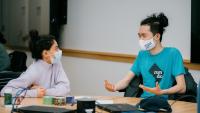Food Insecurity in the Community
Christina Villanueva (MS), Nandini Kannan (MPH), Kristy Medina (MPH), and Karla Maldonado (Program Coordinator, NYP)

For every one supermarket, there are 13 bodegas in the Washington Heights/Inwood neighborhood of New York City. Convenience stores can lack fresh produce, and have a higher availability of processed, packaged foods. Communities with limited access to healthy and nutritious foods are at a higher risk for chronic diseases and food insecurity. Food insecurity has long ravaged underserved communities, and the pandemic has worsened the situation. Community programs such as NYP CHALK (Choosing Healthy & Active Lifestyles for Kids) and NYP CCHN (Center for Community Health Navigation) work closely together with the community to aid in reducing this concern.
This workshop will highlight the various definitions and aspects of food insecurity. We will discuss how it affects local communities and individual households. Through case studies and group discussion, we will illustrate the whole picture of the contributions, and navigate the needs of all parts of the community – its residents, culture, community and faith-based organizations, the infrastructure and more. A community health worker (CHW) will share their frontline experience in supporting patient’s food insecurity and managing chronic conditions. The phrase “it takes a village” will take on a new meaning when fighting hunger, especially when thinking about how the social narrative of a patient ties into their health.